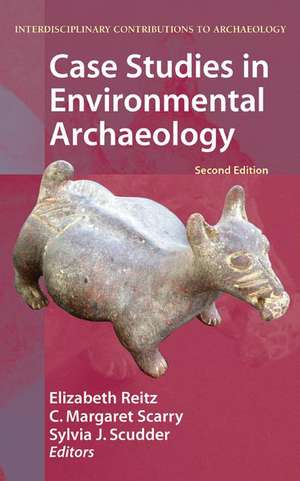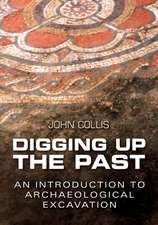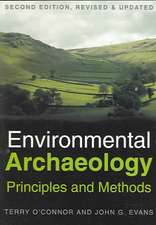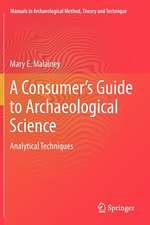Case Studies in Environmental Archaeology: Interdisciplinary Contributions to Archaeology
Editat de Elizabeth Reitz, C. Margaret Scarry, Sylvia J. Scudderen Limba Engleză Hardback – 10 dec 2007
| Toate formatele și edițiile | Preț | Express |
|---|---|---|
| Paperback (1) | 432.33 lei 6-8 săpt. | |
| Springer – 6 dec 2007 | 432.33 lei 6-8 săpt. | |
| Hardback (1) | 404.13 lei 6-8 săpt. | |
| Springer – 10 dec 2007 | 404.13 lei 6-8 săpt. |
Din seria Interdisciplinary Contributions to Archaeology
- 24%
 Preț: 805.82 lei
Preț: 805.82 lei - 20%
 Preț: 817.75 lei
Preț: 817.75 lei - 15%
 Preț: 644.95 lei
Preț: 644.95 lei - 20%
 Preț: 630.27 lei
Preț: 630.27 lei - 15%
 Preț: 646.94 lei
Preț: 646.94 lei - 18%
 Preț: 962.49 lei
Preț: 962.49 lei - 15%
 Preț: 649.54 lei
Preț: 649.54 lei - 15%
 Preț: 583.43 lei
Preț: 583.43 lei - 15%
 Preț: 646.94 lei
Preț: 646.94 lei - 18%
 Preț: 960.61 lei
Preț: 960.61 lei - 15%
 Preț: 584.90 lei
Preț: 584.90 lei - 15%
 Preț: 518.92 lei
Preț: 518.92 lei - 15%
 Preț: 646.62 lei
Preț: 646.62 lei - 18%
 Preț: 948.27 lei
Preț: 948.27 lei - 15%
 Preț: 650.04 lei
Preț: 650.04 lei - 15%
 Preț: 645.60 lei
Preț: 645.60 lei - 18%
 Preț: 778.42 lei
Preț: 778.42 lei - 18%
 Preț: 1118.62 lei
Preț: 1118.62 lei - 18%
 Preț: 945.13 lei
Preț: 945.13 lei - 18%
 Preț: 1121.76 lei
Preț: 1121.76 lei - 18%
 Preț: 957.44 lei
Preț: 957.44 lei - 15%
 Preț: 644.95 lei
Preț: 644.95 lei - 15%
 Preț: 648.89 lei
Preț: 648.89 lei - 18%
 Preț: 949.55 lei
Preț: 949.55 lei - 18%
 Preț: 946.39 lei
Preț: 946.39 lei - 18%
 Preț: 967.40 lei
Preț: 967.40 lei - 18%
 Preț: 950.33 lei
Preț: 950.33 lei - 15%
 Preț: 641.38 lei
Preț: 641.38 lei - 18%
 Preț: 1232.71 lei
Preț: 1232.71 lei - 15%
 Preț: 648.24 lei
Preț: 648.24 lei - 15%
 Preț: 644.82 lei
Preț: 644.82 lei - 18%
 Preț: 2127.22 lei
Preț: 2127.22 lei - 18%
 Preț: 957.62 lei
Preț: 957.62 lei - 15%
 Preț: 586.37 lei
Preț: 586.37 lei - 18%
 Preț: 1230.66 lei
Preț: 1230.66 lei - 18%
 Preț: 1422.77 lei
Preț: 1422.77 lei - 18%
 Preț: 962.35 lei
Preț: 962.35 lei - 18%
 Preț: 1231.16 lei
Preț: 1231.16 lei - 15%
 Preț: 641.71 lei
Preț: 641.71 lei - 15%
 Preț: 649.06 lei
Preț: 649.06 lei - 18%
 Preț: 952.40 lei
Preț: 952.40 lei - 15%
 Preț: 645.96 lei
Preț: 645.96 lei
Preț: 404.13 lei
Nou
Puncte Express: 606
Preț estimativ în valută:
77.35€ • 84.05$ • 65.02£
77.35€ • 84.05$ • 65.02£
Carte tipărită la comandă
Livrare economică 21 aprilie-05 mai
Preluare comenzi: 021 569.72.76
Specificații
ISBN-13: 9780387713021
ISBN-10: 0387713026
Pagini: 463
Ilustrații: XVIII, 463 p.
Dimensiuni: 156 x 235 x 26 mm
Greutate: 0.79 kg
Ediția:2nd ed. 2008
Editura: Springer
Colecția Springer
Seria Interdisciplinary Contributions to Archaeology
Locul publicării:New York, NY, United States
ISBN-10: 0387713026
Pagini: 463
Ilustrații: XVIII, 463 p.
Dimensiuni: 156 x 235 x 26 mm
Greutate: 0.79 kg
Ediția:2nd ed. 2008
Editura: Springer
Colecția Springer
Seria Interdisciplinary Contributions to Archaeology
Locul publicării:New York, NY, United States
Public țintă
Academic/professional/technical: Research and professionalCuprins
Preface.- Acknowledgments.- List of Figures.- List of Tables.- 1 Introduction to Environmental Archaeology.- 1.1 Introduction.- 1.2 What is Environmental .- Archaeology?.- Humanity, History, or Science?.- The Scientific Method and Why it .- Matters.- Method or Theory?.- Artifact or Ecofact?.- Summary.- 1.3 History and Theory in Environmental Archaeology.- History.- Theory.- 1.4 Ecological Concepts.- 1.5 The Disciplines of Environmental Archaeology.- 1.6 The Goals of Environmental Archaeology.- Environmental History: Climate, Landscapes, and Biogeography.- Human/environmental Relationships.- The Evolution of Human Social Institutions.- Improvements in Methodology.- 1.7 Goals of this Book.- 2 Factors Affecting the Composition of an Assemblage (New Chapter).- 2.1 Introduction.- 2.2 Taphonomy.- 2.3 Archaeological Transformational Processes.- 2.4 Cultural Transformations.- Types of Sites.- Cultural Transformations.- Summary.- 2.5 Systemic Context Transformations.- Abiotic Transformations.-Soil Chemistry.- Climate.- Mechanical Damage (alluvial, coastal, fluvial, aeolian).- Aerobic Environments.- Biotic Transformations.- Summary.- 2.6 Ethnoarchaeology and Experimental Archaeology.- 2.7 Summary.- 3 Research Designs and Field Methods (New Chapter).- 3.1 Introduction.- The Role of the Environmental Archaeologist in Field Work.- 3.2 Research Designs.- 3.3 The Importance of Context.- What is a site?.- On-site and off-site testing.- Features and Zones.- Column Samples.- Continguous/Block Excavations.- Random, Stratified Units.- 3.4 Recovery Techniques.- In situ Recovery.- Point Samples.- Screening.- Flotation.- 3.5 Field Sampling.- 3.6 Special Finds.- Burials.- Coprolites and Dung Residue.- Hearths.- 3.7 Record-keeping.- 3.8 Anticipating Radiocarbon Dating and Other Studies.- 3.9 The Ethics of Archaeology.- Cultural Patrimony.- Curating Samples.- 3.10 Summary.- 4 Classification and Nomenclature (New Chapter).- 4.1 Introduction.- 4.2 Folk Taxonomy.- 4.3 Linnaean Taxonomy.- 4.4 The Importance of Comparative Collections.- 4.5 Summary.- 5 Sediments and Soils (Update).- 5.1 Introduction.- 5.2 Taxonomy and Morphology of Soils and Sediments.- 5.3 Field Considerations.- 5.4 Laboratory Procedures for Sediments.- 5.5 Laboratory Procedures for Soils.- 5.6 Applications and Case Studies.- Petrofabric Analysis.- Grain Surface Textures.- Micromorphology.- Environments of Deposition.- Sediment Accumulation and Distribution: Rates and Problems.- Barrow Construction and Soil Interpretation.- Soils as Landscape Remnants.- Phosphate and Manganese in Archaeological Soils.- 5.7 Summary.- 6 Seeds, Fruits, Nuts, and Tubers (Update).- 6.1 Introduction.- 6.2 Taxonomy and Morphology.- 6.3 Field Considerations.- 6.4 Laboratory Procedures.- 6.5 Evidence for Domestication.- 6.6 Applications and Case Studies.- Carbonized Material at Ur.- Seeds and Fruit from Burials.- Coprolites as Evidence of Diet.- The Problem of Mummy Wheat.- The Origins of British Brewing.- The Interpretation of Crops.- Impressions.- 6.7 Summary.- 7 Wood and Charcoal (Update).- 7.1 Introduction.- 7.2 Taxonomy and Morphology.- 7.3 Field Considerations.- 7.4 Laboratory Procedures.- 7.5 Dendrochronology and Radiocarbon Dating.- 7.6 Applications and Case Studies.- Charcoal as Paleoenvironmental Evidence.- Charcoal and Plaster Impressions from Myrtos.- Wood Remains from York.- Trackways in the Somerset Levels.- The Organization of Roman Military Timber Supply.- 7.7 Summary.- 8 Pollen (Update).- 8.1 Introduction.- 8.2 Taxonomy and Morphology.- 8.3 Field Considerations.- 8.4 Laboratory Procedures.- 8.5 Pollen in Special Contexts.- Mineral Soils.- Coprolites.- Stomach Contents.- 8.6 Applications and Case Studies.- Fodder.- Landscape Change.- Climate Change.- Caves and Coprolites.- The Elm Decline.- 8.7 Summary.- 9 Phytoliths, Starch Grains, and Spores (Reorganized from other Chapters).- 9.1 Introduction.- 9.2 Taxonomy and Morphology.- 9.3 Fiel
Textul de pe ultima copertă
The purpose of Case Studies in Environmental Archaeology is to highlight studies addressing significant anthropological issues in the Americas from the perspective of environmental archaeology. Environmental archaeology encompasses the application of biological and geological techniques to the study of human/environmental interactions. Each chapter is an original or revised work by internationally-recognized geoarchaeologists, human biologists, paleoethnobotanists, and zooarchaeologists. Each study demonstrates how and why the information obtained using environmental techniques is important to anthropologists instead of describing, critiquing, or advocating a method. These ethnographic, geological, and biological case studies successfully demonstrate the application of environmental science toward the resolution of questions related to human behavior in the past.
This second edition is based on the 1996 book of the same title. The editors have invited back a number ofcontributors from the first edition to revise and update their chapter. They also have included new studies in order to cover recent developments in the field or additional pertinent topics. It also includes a separate index listing the scientific and vernacular names of plants and animals referenced in the volume.
These case studies present examples from sites in North America, the Caribbean, and South America. Some of the key topics addressed in this unique volume include:
Systemic relationships between people and the physical environments and paleoenvironments in which they live
Relationships among landscapes, resource use, residential patterns, and political alliances
Issues involving human nutrition, health, mobility, sedentism, plant and animal domestication, diet, and trade
Subsistence strategies and resource availability
Intra-community social relations, rural/urban relationships, ethnicidentity, and the development of social complexity
This second edition is based on the 1996 book of the same title. The editors have invited back a number ofcontributors from the first edition to revise and update their chapter. They also have included new studies in order to cover recent developments in the field or additional pertinent topics. It also includes a separate index listing the scientific and vernacular names of plants and animals referenced in the volume.
These case studies present examples from sites in North America, the Caribbean, and South America. Some of the key topics addressed in this unique volume include:
Systemic relationships between people and the physical environments and paleoenvironments in which they live
Relationships among landscapes, resource use, residential patterns, and political alliances
Issues involving human nutrition, health, mobility, sedentism, plant and animal domestication, diet, and trade
Subsistence strategies and resource availability
Intra-community social relations, rural/urban relationships, ethnicidentity, and the development of social complexity
Caracteristici
Second Edition features 6 new chapters, and all chapters updated or revised Uses case studies to resolve questions related to human behavior in the past rather than to demonstrate the application of methods Features comprehensive flora and fauna index















